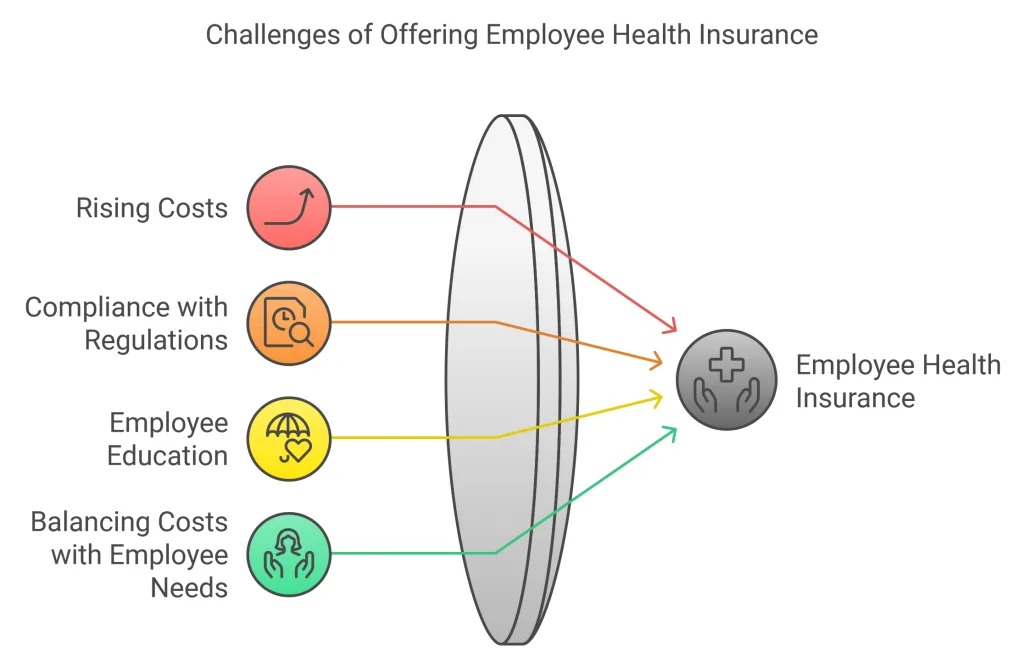
Introduction
Employee health insurance is a vital part of the benefits offered by businesses in the USA. It not only helps to ensure the well-being of employees but also plays a key role in attracting and retaining top talent. In this article, we’ll break down everything you need to know about employee health insurance in the USA for 2024. We’ll cover the types of plans available, legal requirements, how to choose the right plan for your employees, and emerging trends in healthcare. Whether you’re a small business owner or managing a large workforce, this guide will help you navigate the complex world of employee health benefits.
What is Employee Health Insurance?
Employee health insurance is a benefit provided by employers that helps cover the healthcare costs of employees. The costs of premiums are typically shared between the employer and the employee, and the insurance covers medical expenses such as doctor visits, hospital stays, and prescription drugs.
Why is it important? Well, health insurance is often one of the most significant benefits an employer can offer. It helps reduce out-of-pocket medical costs for employees and gives them peace of mind that they are covered in case of illness or injury. According to the Kaiser Family Foundation, around 55% of Americans receive health insurance through their employers, making it a crucial benefit for most workers in the country.
Key Features of Health Insurance Plans
Employee health insurance plans typically include the following features:
- Premiums: The monthly amount paid by the employer and employee to keep the insurance policy active.
- Deductibles: The amount an employee must pay before the insurance company begins to cover medical expenses.
- Co-pays and Co-insurance: These are out-of-pocket costs that employees may pay for specific services, such as doctor visits or prescription drugs.
- Networks: Health insurance plans often have networks of healthcare providers. Employees may need to choose from in-network doctors and hospitals to receive full coverage.
Types of Employee Health Insurance Plans in the USA
There are several types of employee health insurance plans available, each with its own pros and cons. Here’s a breakdown of the most common ones:
1. Health Maintenance Organization (HMO) Plans
An HMO plan requires employees to use healthcare providers within a specified network. If they need to see a specialist, they often need a referral from their primary care physician. While HMOs typically have lower premiums and out-of-pocket costs, the limited network can be a downside for employees who prefer to see out-of-network doctors.
2. Preferred Provider Organization (PPO) Plans
PPO plans give employees more flexibility. They can visit any doctor or specialist without needing a referral, and they are not limited to a specific network. However, PPO plans often come with higher premiums and deductibles than HMO plans.
3. Exclusive Provider Organization (EPO) Plans
EPOs are a blend of HMOs and PPOs. Like HMOs, they require employees to use healthcare providers within a network, but they don’t require a referral to see a specialist. EPOs offer more flexibility than HMOs but often come with higher premiums.
4. High-Deductible Health Plans (HDHPs) with Health Savings Accounts (HSAs)
HDHPs have lower premiums but higher deductibles. They are paired with a Health Savings Account (HSA), which allows employees to save money tax-free for medical expenses. This option is good for employees who are generally healthy and don’t expect high medical costs but want a financial safety net for emergencies.
Choosing the Best Plan
Selecting the best health insurance plan for your employees depends on several factors, including the size of your workforce, your budget, and the specific needs of your employees. It’s a good idea to involve employees in the decision-making process by gathering feedback on their preferences and healthcare needs.

Employee Health Insurance Requirements under the ACA (Affordable Care Act)
The Affordable Care Act (ACA), also known as Obamacare, introduced several regulations for employee health insurance that employers need to be aware of. Understanding these regulations is essential for staying compliant with the law and avoiding penalties.
1. Employer Mandate
Under the ACA, businesses with 50 or more full-time employees are required to provide health insurance to at least 95% of their full-time employees. This is known as the Employer Mandate. If a company fails to meet this requirement, it may face penalties. Small businesses with fewer than 50 employees are not required to provide health insurance but may still choose to do so to remain competitive in the job market.
2. Minimum Essential Coverage
The insurance plan provided by the employer must meet the minimum essential coverage requirements set by the ACA. This means the plan must cover essential health benefits such as hospitalization, prescription drugs, maternity care, and preventive services.
3. Small Business Exemptions
Small businesses with fewer than 50 employees are exempt from the Employer Mandate, but they can still offer health insurance through the Small Business Health Options Program (SHOP). The SHOP marketplace allows small businesses to compare and purchase health insurance plans for their employees. There are also tax credits available for small businesses that offer health insurance, which can help reduce the overall cost.
4. Penalties for Non-Compliance
Businesses that fail to provide health insurance as required by the ACA may face significant financial penalties. These penalties can range from $2,000 to $3,000 per employee, depending on the situation. It’s crucial for employers to understand the ACA regulations to avoid these costly penalties.
For more detailed information on the ACA’s impact on employee health insurance, visit the official Healthcare.gov website.
Benefits of Offering Health Insurance to Employees
Offering health insurance is not just about legal compliance—it also brings a host of benefits for both employers and employees. Here’s why health insurance is a win-win for your business:

1. Employee Retention and Job Satisfaction
Employees who receive health insurance from their employer are more likely to stay with the company. Health benefits are a significant factor in job satisfaction, and offering comprehensive health coverage can help reduce turnover rates.
2. Improved Productivity and Reduced Absenteeism
Healthy employees are productive employees. By offering health insurance, employers can help ensure that their workforce has access to preventive care and early treatment for illnesses. This reduces the number of sick days taken and improves overall productivity.
3. Attracting Top Talent
In a competitive job market, offering health insurance can set your company apart. Many job seekers prioritize health benefits when considering job offers. Providing comprehensive health coverage can help you attract and retain high-quality talent.
4. Financial Incentives and Tax Credits for Businesses
Employers who offer health insurance may be eligible for tax credits and deductions. For example, small businesses can qualify for a tax credit of up to 50% of the cost of employee premiums through the Small Business Health Care Tax Credit. This can make offering health insurance more affordable for small employers.
For more information on tax benefits for businesses offering health insurance, check out this guide from the IRS.
How to Choose the Right Health Insurance Plan for Your Employees
Choosing the right health insurance plan for your employees is a big decision. Here are some key factors to consider:
1. Coverage Options
Consider the types of coverage your employees need. Do they need coverage for family members? Are mental health and dental services important? Look for plans that provide a broad range of services to meet the needs of your workforce.
2. Premiums and Deductibles
Balancing the cost of premiums with the deductibles employees will need to pay is critical. High-deductible plans may be more affordable for employers, but they can be challenging for employees who have high healthcare costs. Make sure to find a balance that works for both parties.
3. Employee Input
Survey your employees to get their feedback on their healthcare needs. Do they prefer lower premiums or lower deductibles? Are they interested in HSAs? Employee input can help guide your decision and ensure that the plan you choose meets their needs.
4. Comparing Plans
Use resources like Healthcare.gov’s comparison tool or work with an insurance broker to compare different health insurance plans. Make sure to evaluate each plan’s network of providers, coverage options, and costs.
Current Trends in Employee Health Insurance for 2024

Healthcare is always evolving, and staying up-to-date on the latest trends can help you offer the best benefits to your employees. Here are some key trends to watch for in 2024:
1. Telemedicine and Virtual Health Coverage
With the rise of telemedicine, more health insurance plans are covering virtual doctor visits. This can be a cost-effective option for both employers and employees, and it provides greater access to healthcare for those in remote areas.
2. Mental Health and Wellness Programs
Mental health has become a top priority for many employers. In 2024, expect to see more health insurance plans that include mental health services, such as therapy and counseling, as part of their coverage.
3. Customizable Health Plans
Employers are increasingly offering tiered or customizable health plans that allow employees to choose the coverage that best fits their needs. This can help employers control costs while giving employees more options.
4. Preventive Care and Wellness Programs
Many insurance plans are putting a greater emphasis on preventive care, such as regular health checkups and screenings. Wellness programs that encourage healthy lifestyles, such as gym memberships and smoking cessation programs, are also becoming more common.
To learn more about these trends, check out this article from Forbes on healthcare trends for 2024.
Challenges of Offering Employee Health Insurance
While there are many benefits to offering health insurance, there are also challenges that employers need to be aware of.
1. Rising Costs
Healthcare costs continue to rise, making it more expensive for businesses to offer comprehensive health insurance. Employers need to find ways to manage these costs while still providing valuable benefits to their employees.
2. Compliance with Regulations
Navigating the legal requirements of the ACA and other healthcare laws can be challenging, especially for small businesses. Employers need to stay informed about the latest regulations to avoid penalties.
3. Employee Education
Many employees don’t fully understand their health insurance benefits. Employers need to invest time in educating their workforce about the coverage options available to them and how to make the most of their benefits.
4. Balancing Costs with Employee Needs
It can be difficult to find a health insurance plan that balances affordability with the coverage that employees need. Employers must carefully evaluate their options and consider employee input to make the best decision.
For more information on managing these challenges, visit the National Federation of Independent Business (NFIB) for small business resources.

Conclusion
Employee health insurance is an essential benefit that can significantly impact the success of your business. By offering comprehensive health coverage, you can attract and retain top talent, improve productivity, and boost employee satisfaction. However, it’s important to understand the different types of plans, legal requirements, and emerging trends to make the best decision for your employees and your business.
Staying compliant with regulations like the ACA, offering customizable and modern health plans, and focusing on wellness initiatives are all key strategies for success in 2024. Remember, offering health insurance is not just a legal obligation for many businesses—it’s also a smart investment in your workforce and your company’s future.
For more in-depth information on employee health insurance, visit trusted resources like Healthcare.gov or consult with an insurance broker who can help you navigate the options available to your business.
What is Employee Health Insurance in the USA, and how does it work?
Employee Health Insurance is a benefit provided by employers to help cover medical expenses for employees and their families. Employers either cover the full premium or share the cost with employees. Plans can vary based on the insurance provider and employer policies, offering different coverage options like doctor visits, hospital stays, and prescription drugs. For more details, visit the official U.S. Department of Health & Human Services website here.
What are the benefits of Employee Health Insurance in 2024?
In 2024, Employee Health Insurance continues to offer essential medical coverage, including preventive care, emergency services, and mental health support. It often includes wellness programs to promote healthy living, reduced premiums through group rates, and comprehensive network coverage. Additionally, KFF.org provides valuable resources on healthcare trends and insurance options.
Who is eligible for Employee Health Insurance in the USA?
Typically, full-time employees are eligible for Employee Health Insurance, though eligibility can vary by employer. Some companies also offer coverage to part-time employees or extend benefits to dependents. Each employer may have different waiting periods and criteria before coverage begins. Explore more eligibility criteria on Healthcare.gov.
What are the common types of Employee Health Insurance plans in 2024?
In 2024, common types of Employee Health Insurance plans include Health Maintenance Organizations (HMOs), Preferred Provider Organizations (PPOs), and High-Deductible Health Plans (HDHPs) paired with Health Savings Accounts (HSAs). Each plan type offers different levels of flexibility and cost-sharing between the employer and the employee. For a deeper comparison of these plans, check eHealth.
How can I choose the best Employee Health Insurance plan for my needs?
When choosing an Employee Health Insurance plan, consider factors like your healthcare needs, preferred doctors, network restrictions, and out-of-pocket costs. Compare the premium, deductible, and co-pay amounts before deciding. It’s also helpful to review past medical expenses to estimate future needs.
Are mental health services covered under Employee Health Insurance in 2024?
Yes, many Employee Health Insurance plans in 2024 cover mental health services, including therapy, counseling, and medications. Mental health is considered an essential health benefit under the Affordable Care Act, so most plans are required to provide this coverage. Check with your employer to understand specific benefits. More details on mental health insurance coverage can be found at MentalHealth.gov.
How has Employee Health Insurance changed in 2024 compared to previous years?
In 2024, Employee Health Insurance has seen increased focus on mental health, telemedicine services, and expanded preventive care. Employers are also offering more personalized wellness programs to encourage healthier lifestyles. The trend toward High-Deductible Health Plans paired with Health Savings Accounts has continued to grow. For the latest updates on health insurance changes, visit Health Affairs.
What is the difference between employer-sponsored and marketplace Employee Health Insurance?
Employer-sponsored Employee Health Insurance is offered directly by your employer, often with shared costs. Marketplace insurance, purchased through Healthcare.gov, provides more plan choices but may come at a higher cost since there is no employer contribution. Subsidies may be available based on income. Find more on Marketplace plans at Healthcare.gov.
Can I keep my Employee Health Insurance if I leave my job?
Yes, through the Consolidated Omnibus Budget Reconciliation Act (COBRA), you may continue your Employee Health Insurance for a limited time after leaving your job. However, you will be responsible for the full premium, which may be significantly higher than what you were paying while employed.
What happens if my employer doesn’t offer Employee Health Insurance?
If your employer doesn’t offer Employee Health Insurance, you can explore individual health plans through the Health Insurance Marketplace or consider alternative options like Medicaid if eligible. You may also qualify for subsidies to help cover costs if you meet certain income requirements. For affordable health plan options, visit Healthcare.gov.
Need More Details about the content? Reach us on our Contact Us page.